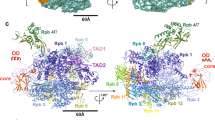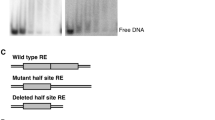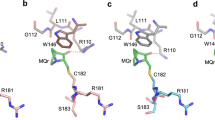Abstract
Recently we have shown that wild-type human p53 protein binds preferentially to supercoiled (sc) DNA in vitro in both the presence and absence of the p53 consensus sequence (p53CON). This binding produces a ladder of retarded bands on an agarose gel. Using immunoblotting with the antibody DO-1, we show that the bands obtained correspond to ethidium-stained DNA, suggesting that each band of the ladder contains a DNA-p53 complex. The intensity and the number of these bands are decreased by physiological concentrations of zinc ions. At higher zinc concentrations, binding of p53 to scDNA is completely inhibited. The binding of additional zinc ions to p53 appears much weaker than the binding of the intrinsic zinc ion in the DNA binding site of the core domain. In contrast to previously published data suggesting that 100 μM zinc ions do not influence p53 binding to p53CON in a DNA oligonucleotide, we show that 5 – 20 μM zinc efficiently inhibits binding of p53 to p53CON in DNA fragments. We also show that relatively low concentrations of dithiothreitol but not of 2-mercaptoethanol decrease the concentration of free zinc ions, thereby preventing their inhibitory effect on binding of p53 to DNA. Nickel and cobalt ions inhibit binding of p53 to scDNA and to its consensus sequence in linear DNA fragments less efficiently than zinc; cobalt ions are least efficient, requiring >100 μM Co2+ for full inhibition of p53 binding. Modulation of binding of p53 to DNA by physiological concentrations of zinc might represent a novel pathway that regulates p53 activity in vivo.
This is a preview of subscription content, access via your institution
Access options
Subscribe to this journal
Receive 50 print issues and online access
$259.00 per year
only $5.18 per issue
Buy this article
- Purchase on Springer Link
- Instant access to full article PDF
Prices may be subject to local taxes which are calculated during checkout






Similar content being viewed by others
References
Arrowsmith CH and Morin P. . 1996 Oncogene 12: 1379–1385.
Beltran R, Martinez-Balbas A, Bernues J, Bowater R and Azorin F. . 1993 J. Mol. Biol. 230: 966–978.
Berg JM and Shi Y. . 1996 Science 271: 1081–1085.
Bernues J, Beltran R, Casasnovas JM and Azorin F. . 1989 EMBO J. 8: 2087–2094.
Bradford MM. . 1976 Anal. Biochem. 72: 248–254.
Bullock AN, Henckel J, Dedecker BS, Johnson CM, Nikolova PV, Proctor MR, Lane DP and Fersht AR. . 1997 Proc. Natl. Acad. Sci. USA 94: 14338–14342.
Cho Y, Gorina S, Jeffrey PD and Pavletich NP. . 1994 Science 265: 346–355.
Christianson DW. . 1991 In: Advances in protein chemistry, Vol. 42. Anfinsen CB, Edsall JT and Richards FM. (eds). Academic Press: San Diego pp.281–353.
Coffer AI and Knowles PP. . 1994 Biochim. Biophys. Acta 1209: 279–285.
Cornell NW and Crivaro KE. . 1972 Anal. Biochem. 47: 203–208.
Cox LS and Lane DP. . 1995 BioEssays 17: 501–508.
Ebadi M and Iversen PL. . 1994 Gen. Pharmac. 25: 1297.
El-Deiry WS, Kern SE, Pietenpol, JA, Kinzler KW and Vogelstein B. . 1992 Nature Genet 1: 45–49.
Elledge RM and Lee W-H. . 1995 BioEssays 17: 923–930.
Glusker JP. . (1991). In: Advances in protein chemistry Vol. 42. Anfinsen CB, Edsall JT, Richards FM and Eisenberg DS. (eds). Academic Press: San Diego pp.1–75.
Hainaut P and Milner J. . 1993 Cancer Res. 53: 1739–1742.
Hainaut P, Rolley N, Davies M and Milner J. . 1995 Oncogene 10: 27–32.
Han W, Dlakic M, Zhu YJ, Lindsay SM and Harrington RE. . 1997a Proc. Natl. Acad. Sci. USA 94: 10565.
Han W, Lindsay SM, Dlakic M and Harrington RE. . 1997b Nature 386: 563.
Harlow E and Lane D. . 1988 Antibodies. A Laboratory Manual 497–501 Cold Spring Harbor Laboratory.
Hunt JB, Neece SH and Ginsburg A. . 1985 Anal. Biochem. 146: 150–157.
Hupp TR and Lane DP. . 1994 Curr. Biol. 4: 865–875.
Jacob C, Maret W and Vallee BL. . 1998 Proc. Natl. Acad. Sci. USA 95: 3489.
Klevickis C and Grisham CM. . 1996 In: Metal ions in biological systems. Interactions of metal ions with nucleotides, nucleic acids and their constituents. Vol. 32. Sigel A and Sigel H. (eds).. Marcel Dekker: New York pp.1–26.
Ko LJ and Prives C. . 1996 Genes Dev. 10: 1054–1072.
Laundon C and Griffith JD. . 1987 Biochemistry 26: 3759.
Levine AJ. . 1997 Cell 88: 323–331.
Martinez-Balbas A and Azorin F. . 1993 Nucleic Acids Res. 21: 2557–2562.
Mundt M, Hupp T, Fritsche M, Merkle C, Hansen S, Lane D and Groner B. . 1997 Oncogene 15: 237–244.
Nagaich AK, Appella E and Harrington RE. . 1997a J. Biol. Chem. 272: 14842–14849.
Nagaich AK, Zhurkin VB, Sakamoto H, Gorin AA, Clore GM, Gronenborn AM, Appella E and Harrington RE. . 1997b J. Biol. Chem. 272: 14830–14841.
Nagel WW and Valle BL. . 1995 Proc. Natl. Acad. Sci. USA 92: 579–583.
Ortiz-Lombardia M, Eritja R, Azorin F, Kypr J, Tejralova I and Vorlickova M. . 1995 Biochemistry 34: 14408–14415.
Palecek E. . 1991 Crit. Rev. Biochem. Mol. Biol. 26: 151–226.
Palecek E, Tomschik M, Stankova V and Havran L. . 1997a Electroanalysis 9: 990–997.
Palecek E, Vlk D, Stankova V, Brazda V, Vojtesek B, Hupp TR, Schaper A and Jovin TM. . 1997b Oncogene 15: 2201–2209.
Parks D, Bolinger R and Mann K. . 1997 Nucleic Acids Res. 25: 1289–1295.
Pavletich NP, Chambers KA and Pabo CO. . 1993 Gene Dev. 7: 2556–2564.
Sabat M and Lippert B. . 1996 In: Metal ions in biological systems. Probing of nucleic acids by metal ion complexes of small molecules. Vol. 33. Marcel Dekker: New York pp.143–176.
Sambrook J, Fritsch EF and Maniatis T. . 1989 Molecular Cloning. A Laboratory Manual, 2nd edn 9.36–9.37 Cold Spring Harbor Laboratory Press.
Soussi T and May P. . 1996 J. Mol. Biol. 260: 623–637.
Stephen CW, Helminen P and Lane DP. . 1995 J. Mol. Biol. 248: 58–78.
Tomschik M, Havran L, Fojta M and Palecek E. . 1998 Electroanalysis 10: 403–406.
Vallee BL and Auld DS. . 1990 Biochemistry 29: 5647–5659.
Verhaegh GW, Parat M-O, Richard M-J and Hainaut P. . 1998 Mol. Carcinog. 21: 205–214.
Vlk D. . 1997 PhD-Thesis, Institute of Biophysics, Academy of Sciences of the Czech Republic, Brno.
Vojtesek B, Bartek J, Midgley CA and Lane DP. . 1992 Immunological Methods 151: 237–244.
Yagil G. . 1991 Crit. Rev. Biochem. Mol. Biol. 26: 475–559.
Acknowledgements
The authors are grateful to Drs M Fojta and M Sheard for stimulating discussions and critical reading of the manuscript. This work was supported by a grant of the Grant Agency of the Czech Republic Nos. 204/96/1680 and 301/99/0692, by Volkswagen Stiftung to E Palecek and Dr T M Jovin and by a grant of the Grant Agency of the Academy of Sciences CR A5004803 to E Palecek, B Vojtesek was partially supported by the grants of IGA MH CR Nos.: 3477-3, 4783-3 and MSMT No. VS 96154.
Author information
Authors and Affiliations
Rights and permissions
About this article
Cite this article
Paleček, E., Brázdová, M., Černocká, H. et al. Effect of transition metals on binding of p53 protein to supercoiled DNA and to consensus sequence in DNA fragments. Oncogene 18, 3617–3625 (1999). https://doi.org/10.1038/sj.onc.1202710
Received:
Revised:
Accepted:
Published:
Issue Date:
DOI: https://doi.org/10.1038/sj.onc.1202710
Keywords
This article is cited by
-
Novel mechanism of base excision repair inhibition by low-dose nickel(II): interference of p53-mediated APE1 function
Molecular & Cellular Toxicology (2021)
-
Strong preference of BRCA1 protein to topologically constrained non-B DNA structures
BMC Molecular Biology (2016)
-
Zinc and human health: an update
Archives of Toxicology (2012)
-
Transcriptional regulation by p53: one protein, many possibilities
Cell Death & Differentiation (2006)
-
Zinc: a multipurpose trace element
Archives of Toxicology (2006)



